IBM QRadar vs Microsoft Sentinel
July 31, 2023 | Author: Michael Stromann
See also:
Top 10 SIEM software
Top 10 SIEM software
IBM QRadar and Microsoft Sentinel are two prominent security information and event management (SIEM) solutions, each with its own set of unique features and capabilities. IBM QRadar, developed by IBM Security, is known for its robust and scalable architecture, making it suitable for large enterprises and complex environments. It excels in real-time threat detection and analysis by correlating data from various sources, including network traffic, logs, and endpoints. QRadar's strength lies in its ability to analyze vast amounts of data and generate actionable insights, coupled with its extensive support for integration with third-party security tools. On the other hand, Microsoft Sentinel is a cloud-native SIEM platform integrated with the Microsoft Azure ecosystem. It offers a centralized view of an organization's security landscape, utilizing advanced analytics and automation to detect and respond to security incidents effectively. Sentinel's AI-driven capabilities enable it to analyze massive amounts of data across diverse sources, including logs, cloud services, and endpoints, providing a broader and more holistic view of an organization's security posture within the Azure environment.
Another key difference between IBM QRadar and Microsoft Sentinel lies in their integration with other platforms and services. IBM QRadar is a versatile SIEM solution that can integrate with various security tools, both from IBM and third-party vendors, enhancing its capabilities and adaptability to different environments. On the other hand, Microsoft Sentinel is deeply integrated with the Microsoft Azure platform and other Microsoft services, providing a seamless security experience for organizations heavily invested in the Azure ecosystem. This integration can be advantageous for businesses seeking to leverage their existing investments in Microsoft technologies and cloud services for a unified security approach.
Additionally, the deployment models of the two platforms differ. IBM QRadar can be deployed on-premises or in a hybrid environment, catering to organizations with specific data privacy and compliance needs. It provides flexibility in data storage and management while keeping sensitive information within an organization's infrastructure. On the other hand, Microsoft Sentinel is a cloud-native solution, offering the benefits of scalability, automatic updates, and reduced maintenance overheads. Organizations that prioritize cloud-based solutions and seek to leverage the advantages of a cloud-native SIEM may find Microsoft Sentinel more suitable for their requirements. When making a decision between IBM QRadar and Microsoft Sentinel, organizations should carefully assess their specific security needs, existing infrastructure, cloud preferences, and the level of integration required to determine the best-fit solution for their cybersecurity strategy.
See also: Top 10 SIEM software
Another key difference between IBM QRadar and Microsoft Sentinel lies in their integration with other platforms and services. IBM QRadar is a versatile SIEM solution that can integrate with various security tools, both from IBM and third-party vendors, enhancing its capabilities and adaptability to different environments. On the other hand, Microsoft Sentinel is deeply integrated with the Microsoft Azure platform and other Microsoft services, providing a seamless security experience for organizations heavily invested in the Azure ecosystem. This integration can be advantageous for businesses seeking to leverage their existing investments in Microsoft technologies and cloud services for a unified security approach.
Additionally, the deployment models of the two platforms differ. IBM QRadar can be deployed on-premises or in a hybrid environment, catering to organizations with specific data privacy and compliance needs. It provides flexibility in data storage and management while keeping sensitive information within an organization's infrastructure. On the other hand, Microsoft Sentinel is a cloud-native solution, offering the benefits of scalability, automatic updates, and reduced maintenance overheads. Organizations that prioritize cloud-based solutions and seek to leverage the advantages of a cloud-native SIEM may find Microsoft Sentinel more suitable for their requirements. When making a decision between IBM QRadar and Microsoft Sentinel, organizations should carefully assess their specific security needs, existing infrastructure, cloud preferences, and the level of integration required to determine the best-fit solution for their cybersecurity strategy.
See also: Top 10 SIEM software





